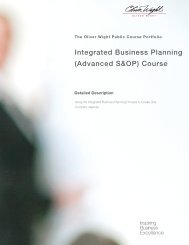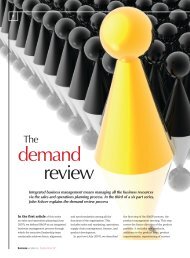People in Teams - Oliver Wight Americas
People in Teams - Oliver Wight Americas
People in Teams - Oliver Wight Americas
Create successful ePaper yourself
Turn your PDF publications into a flip-book with our unique Google optimized e-Paper software.
<strong>People</strong><strong>in</strong>teamsIn part five of his series on manag<strong>in</strong>g and lead<strong>in</strong>g people, Jon M<strong>in</strong>erich, Pr<strong>in</strong>cipal, <strong>Oliver</strong> <strong>Wight</strong><strong>Americas</strong>, Inc., describes how to set up successful teamsEveryone, it seems, is talk<strong>in</strong>gabout teams, teamwork,and team build<strong>in</strong>g. SmartCEOs know that teamworkis crucial to accomplish<strong>in</strong>gtheir company’s strategic goals, andalso that there is more to it thanassembl<strong>in</strong>g a collection of <strong>in</strong>dividualsto work together.The concept of teams <strong>in</strong> bus<strong>in</strong>essis not new, yet many companies stillstruggle to deploy them effectively.This is a shame because the properuse of teams will enable CEOs toimprove bus<strong>in</strong>ess results and achievetheir vision.This article expla<strong>in</strong>s how thecontext, structure, and educationof teams determ<strong>in</strong>e their level ofsuccess. We also describe how tocreate a culture of empowerment <strong>in</strong>which teams can flourish.Understand the context of teamutilizationIn the first article (Strategy andleadership), we focused on clearlydef<strong>in</strong><strong>in</strong>g your strategies to achieveyour vision and how your culturewas key to successfully implement<strong>in</strong>git. In the follow<strong>in</strong>g article (Design<strong>in</strong>gand develop<strong>in</strong>g the organization), wedescribed how to design the organizationto support your strategies.When contemplat<strong>in</strong>g the use ofteams, CEOs should first resolve:1. Where do teams fit <strong>in</strong>to the contextof our vision, strategies, and culture?2. How will they help us accomplish ourvision and implement our strategies?3. Will our culture enable teams to besuccessful?4. Is our level of bus<strong>in</strong>ess maturityappropriate to the use of teams?It is important that CEOs andtheir leadership teams clearlyanswer these questions beforeimplement<strong>in</strong>g teams <strong>in</strong>to theircompanies. As with many otherbus<strong>in</strong>ess improvement techniques,bus<strong>in</strong>ess history is replete withstories of failed use of teams.Optimally, bus<strong>in</strong>esses mature overtime. Their bus<strong>in</strong>ess processes, style ofleadership, and ability to successfullyimplement teams need to matureover time as well. To understandthe relationship between teams andbus<strong>in</strong>ess maturity, review and studythe accompany<strong>in</strong>g sidebar (Bus<strong>in</strong>essMaturity Levels: Culture and <strong>Teams</strong>).Clearly def<strong>in</strong>e team structure<strong>Teams</strong> have been described <strong>in</strong> manydifferent ways. In the context of thisarticle, we focus on three types: 1)project teams; 2) functional teams;and 3) process teams.Project teamsProject teams are formed to accomplisha specific task or objective. Theiruseful life is limited, typically 180 daysor less. However, depend<strong>in</strong>g on theproject scope, a team may exist for anextended period. For example, a steer<strong>in</strong>gcommittee or project team for a large ERP(enterprise resource plann<strong>in</strong>g) systemimplementation may work together fortwo years or more. They are chartered withvery clear expectations for performanceand deliverables. Generally they arestaffed with subject matter expertswhose comb<strong>in</strong>ed skills are necessary toaccomplish the given objective.Th<strong>in</strong>k of project teams as “swat”teams whose purpose is to move <strong>in</strong> andresolve a specific bus<strong>in</strong>ess problemand then go back to their normal work6 www.bus-ex.com November 08
S t r a t e g i c m a n a g e m e n trout<strong>in</strong>e when the project is f<strong>in</strong>ished.Functional teamsFunctional teams are very differentfrom project teams <strong>in</strong> that they areput <strong>in</strong>to place to perform a bus<strong>in</strong>essfunction <strong>in</strong>def<strong>in</strong>itely. They generallyoperate with<strong>in</strong> a functional area butalso may work cross-functionally toachieve their mission. We have all heardof the “sales team”, the “procurementteam”, etc.Bus<strong>in</strong>ess activities with<strong>in</strong> adepartment or functional area may beorganized as a process, and teams areassigned to work with<strong>in</strong> these processeswith<strong>in</strong> a functional area. However,these teams rarely extend their workbeyond department boundaries.There are some notable exceptionsto the typical functional team. Thebest example is a safety team. Theseteams typically cross most functionalboundaries and have an <strong>in</strong>def<strong>in</strong>itelifespan. Another example is qualityassessment teams. Like the safetyteam, the quality assessment teamdoes its work across many functionalareas and, like the safety team, has an<strong>in</strong>def<strong>in</strong>ite lifespan.Understand that teams, like thesafety and quality assessment teams,are perform<strong>in</strong>g a very specific bus<strong>in</strong>essfunction, even though their work maycross many departments or functionalboundaries. They should not be confusedBus<strong>in</strong>ess Maturity Levels(Culture and <strong>Teams</strong>)1. Individualism with<strong>in</strong> Functional SilosBehavior: little or no teamwork; “blame culture”; unpredictablebus<strong>in</strong>ess performance; chronic unresolved problems; controlma<strong>in</strong>ta<strong>in</strong>ed by autocratic management.Focus: current problems; task oriented; no sensitivity for thecustomer of work performed.Cultural Impact: open communication, truthfulness, humor, andhonesty rarely exhibited between workforce and management.2. Project <strong>Teams</strong> with<strong>in</strong> Functional SilosBehavior: team identity with<strong>in</strong> departments; “blame culture” stillexists between functional silos or departments.Focus: task teams or problem-solv<strong>in</strong>g teams may be <strong>in</strong> use, someteam build<strong>in</strong>g and team tra<strong>in</strong><strong>in</strong>g is <strong>in</strong> place.Cultural Impact: communication between management andworkforce improv<strong>in</strong>g, but generally sporadic, and one-way.3. Functional <strong>Teams</strong>Behavior: teams aligned to functional processes and work togetherto improve performance.Focus: bus<strong>in</strong>ess plans communicated and understood by all; teambuild<strong>in</strong>g and team tra<strong>in</strong><strong>in</strong>g is standard practice; functional teamsgenerally aligned to bus<strong>in</strong>ess goals.Cultural Impact: less autocratic and more “soft” managementpractices <strong>in</strong> place; open, two-way communication is the norm;truthfulness, humor, and honesty prevail <strong>in</strong> all communications.4. Process <strong>Teams</strong>Behavior: permanent cross-functional teams work<strong>in</strong>g with<strong>in</strong> endto-endbus<strong>in</strong>ess processes.Focus: teams utilized as the primary means to direct, organize, andaccomplish work.Cultural Impact: boundary-less m<strong>in</strong>dset; process focused, freeflow<strong>in</strong>gcommunication across all levels of the organization; workviewed as challeng<strong>in</strong>g and satisfy<strong>in</strong>g.5. Self-Managed <strong>Teams</strong>Behavior: problems anticipated and resolved before customer orbus<strong>in</strong>ess is impacted.Focus: teams set their own goals, based on strategic and tacticalobjectives; teams allocate resources to accomplish the same.Cultural Impact: proactive workforce; success focused, helpful,and empowered; environment of cont<strong>in</strong>uous learn<strong>in</strong>g and bus<strong>in</strong>essimprovement.November 08 www.bus-ex.com 7
Functional <strong>Teams</strong> (with<strong>in</strong> silos)with process teams described next.Process teamsThese teams are the most difficultto implement because traditionalorganizational functions and structuresare elim<strong>in</strong>ated and replaced with endto-endbus<strong>in</strong>ess processes beforethese teams can exist. Implement<strong>in</strong>gthese teams is strategic <strong>in</strong> nature,and due consideration must be givento the organizational upheaval thatmay result. This upheaval extends upand down all levels of the organizationbecause traditional functional rolesand responsibilities, l<strong>in</strong>es of authority,and budgets will be re-written whenimplement<strong>in</strong>g a new organizationalstructure managed by process teams.In the process teams diagram, it canbe seen that “debates” over authoritycan result as functional managersmove <strong>in</strong>to a support<strong>in</strong>g role, andbus<strong>in</strong>ess process owners take overrunn<strong>in</strong>g the bus<strong>in</strong>ess. Refer to thematurity map and understand that anorganization must move from one levelto the next level of bus<strong>in</strong>ess maturityto be successful.Caution: Attempt<strong>in</strong>g to skip a be part of your future state, thenlevel or levels, before the education,<strong>in</strong>frastructure, and experience <strong>in</strong> theorganization are appropriate to move tologically, your people must be educatedon how to work <strong>in</strong> a team environment.This <strong>in</strong>cludes both those employeesProcess <strong>Teams</strong> (end-to-end process)the next level, will result <strong>in</strong> failure! who will work with<strong>in</strong> teams and thoseEducat<strong>in</strong>g and develop<strong>in</strong>g teams who support them.<strong>People</strong> must be educated and tra<strong>in</strong>ed When review<strong>in</strong>g the objectives ofto operate <strong>in</strong> the future state, as this a company’s team education andseries has emphasized. Should teams tra<strong>in</strong><strong>in</strong>g program, CEOs and their8 www.bus-ex.com November 08
S t r a t e g i c m a n a g e m e n tdesignates are advised to consider thefollow<strong>in</strong>g checklist:1. All team members, managers,supervisors, technical, and supportpeople have been formally <strong>in</strong>troducedto the concepts of work teams.2. They understand and can articulatethe differences and proper use ofthe various types of teams (project,functional, and process).3. Everyone has been educated on howroles/jobs will be structured to supportthe team environment.4. Managers, supervisors, andsupport personnel have beeneducated and tra<strong>in</strong>ed on how theywill become coaches, facilitators,customer advocates, “barrier busters”,motivators, and leaders.5. <strong>Teams</strong> have been tra<strong>in</strong>ed on how towork together <strong>in</strong> areas such as rolesand responsibilities of <strong>in</strong>dividual teammembers, appropriate team behaviors,communication, and measur<strong>in</strong>gperformance.6. <strong>Teams</strong> have been technically tra<strong>in</strong>ed<strong>in</strong> data collection, data analysis,problem solv<strong>in</strong>g, project management,and implement<strong>in</strong>g solutions.7. Major improvements and lessonslearned are documented and <strong>in</strong>tegrated<strong>in</strong>to future development programs.Creat<strong>in</strong>g an empowerment cultureTo be successful, teams must be allowedto work <strong>in</strong> an empowered environment.Creat<strong>in</strong>g this environment may, <strong>in</strong>all likelihood, will require a major“overhaul” of the exist<strong>in</strong>g companyculture. That is why the level of teamimplementation must be aligned to thebus<strong>in</strong>ess’s maturity.For CEOs dedicated to mak<strong>in</strong>gtheir teams work effectively, theyshould consider the follow<strong>in</strong>g listof characteristics common to anempowered environment:1. Trust prevails. Open, honest, andconstructive feedback are highlyvalued and demonstrated throughoutthe organization.2. Operat<strong>in</strong>g decisions are made at thelowest levels of the organization.3. There are few status dist<strong>in</strong>ctionsbetween managers and workers.4. “State-of-the-bus<strong>in</strong>ess” meet<strong>in</strong>gsare a regular part of work.5. Resources are allocated to teamscommensurate with the scope of theirwork.6. <strong>Teams</strong> and their <strong>in</strong>dividualmembers are held accountable fortheir performance.7. <strong>Teams</strong> have clear directionand sufficient understand<strong>in</strong>g oftheir objectives, scope of work,responsibilities, timel<strong>in</strong>es, andoperat<strong>in</strong>g guidel<strong>in</strong>es.8. The company recognizes and rewardsteam behavior, not just that of <strong>in</strong>dividuals.9. Management understands that theymust step back and “let go” while, atthe same time, provid<strong>in</strong>g direction andguidance.This list is not all-<strong>in</strong>clusive, but itdoes provide the CEO a reasonableguide of what elements are necessaryfor the bus<strong>in</strong>ess environment tosuccessfully implement teams <strong>in</strong> his/her company.ConclusionImplement<strong>in</strong>g teams with<strong>in</strong> anorganization should not be taken lightly. Acommon phrase heard <strong>in</strong> many executivesuites is, “let’s put together a team toresolve this problem . . . or accomplishthis objective.” Many times this phrase isuttered without a full appreciation of thebus<strong>in</strong>ess changes necessary to executehis/her request. By understand<strong>in</strong>g andfollow<strong>in</strong>g the recommendations presented<strong>in</strong> this article, the CEO’s probability ofachiev<strong>in</strong>g success when implement<strong>in</strong>gteams is greatly enhanced.Next month, our sixth and f<strong>in</strong>alarticle <strong>in</strong> the Manag<strong>in</strong>g and Lead<strong>in</strong>g<strong>People</strong> series will focus on measur<strong>in</strong>gthe results we have learned andimplemented. As Dr. Dem<strong>in</strong>g said, “ . .. we don’t have to measure everyth<strong>in</strong>g,we just have to measure the rightth<strong>in</strong>gs.” Next month, we will learn howto do just that.November 08 www.bus-ex.com 9
















